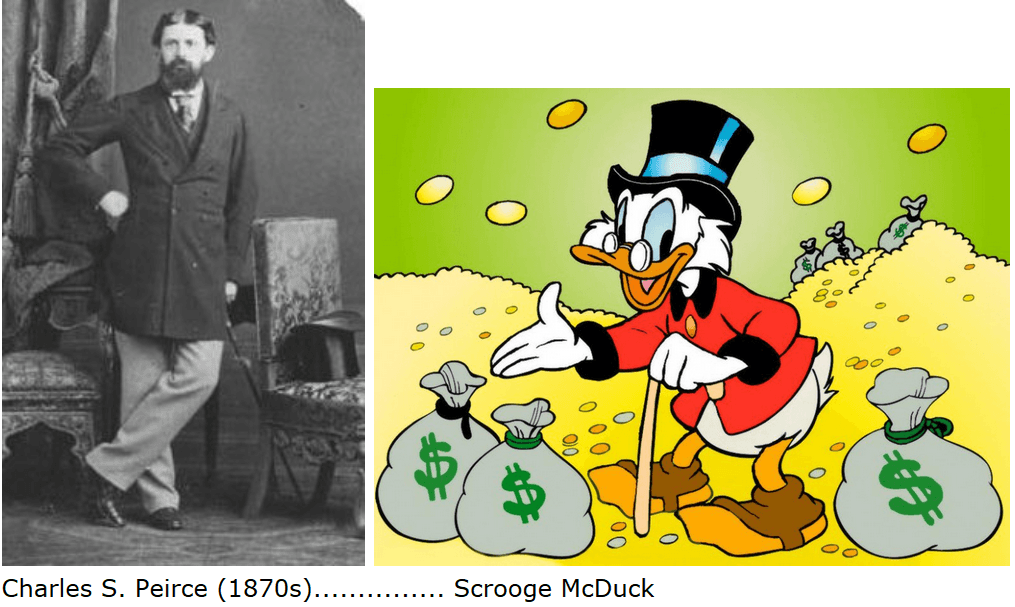The intellectual life of every nation is shaped by its national philosophical tradition. Kant, Hegel, and Heidegger for the Germans. Descartes, Pascal, and Derrida for the French. Dostoevsky and Berdyaev for the Russians. In America, the original local branch of thought, which formed the intellectual landscape of the country, is the Pragmatism associated with the names of Charles Sanders Peirce (1839-1914) and John Dewey (1859-1952).
A part of Pragmatism’s heritage is the attitude towards the science and scientific method. It is not widely known, but the adepts of the Pragmatism believed that intellectual and scientific accomplishments should be measured by the cash value. Thus, the Stanford Encyclopedia of Philosophy states:
“All resources for carrying out research, such as personnel, person-hours, and apparatus, are quite costly; accordingly, it is wasteful, indeed irrational, to squander them. Peirce proposed, therefore, that careful consideration be paid to the problem of how to obtain the biggest epistemological “bang for the buck.” In effect, the economics of research is a cost/benefit analysis in connection with states of knowledge.” https://plato.stanford.edu/entries/peirce/
For more details, please read Nicholas Rescher’s articles, such as his “Peirce and the Economy of Research” Philosophy of Science Vol. 43, No. 1 (Mar., 1976), pp. 71-98 https://www.jstor.org/stable/187336
Certainly, research administrators in Europe and in other regions of the world also use money as a criterion of scientific accomplishments. However, their intellectual traditions have antidotes against that, which we, Americans (either US-born or naturalized like myself) do not posses. European colleagues tend to laugh in disbelief when I tell them that American scholars use research expenditures as a criterion of scientific achievements, and that we even have special research awards for top spenders.

It does not work the way Charles Peirce envisioned it, when he wanted to maximize the number of scientific discoveries per dollar. Somehow it tends to work the opposite way. Researchers prefer maximizing the amount of dollars per even minor discoveries or results. This “bang for the buck” attitude inevitably leads to the maximum “buck for the bang”.
Recently, I have got elected into the Executive Committee of the Natural Sciences Division of my university. This is a committee of peers (scientists from various departments), who establish, among other things, the policy of what constitutes a scientific accomplishment.
After I got this new service assignment, I studied how research accomplishments are defined by various Divisions. The UWM has the total of four divisions:
1. The Division of Natural Sciences:
“Research achievements.The Subcommittee regards evidence based upon scholarship and expertise in research as the foremost criterion for promotion to full professor, provided that the individual’s teaching career has been progressive and successful. Refereed publications, together with funding from government agencies, industry and/or foundations provide prima facie evidence of the candidate’s research accomplishments. The candidate is expected to have achieved a high level of scholarship, expertise and stature in his/her field as evident from a consistent record of refereed research publications, particularly of primary research, and successful research funding.” (Divisional criteria)
2. The Division of Professions
“Research, Scholarship, and Professional Activities. The candidate’s research, scholarship, and professional activities will be evaluated as to whether they are well-conceived and developed, and relevant and critical to the profession. These activities and products will also be evaluated with respect to their impact on and acceptance in the profession, as measured by dissemination in scholarly and professional journals and other appropriate media. The candidate’s research, scholarly, and professional activities will also be assessed for evidence of continuing contribution.” (Divisional criteria)
3. The Division of Social Sciences:
“A scholar has a professional obligation to publish and to subject ideas to the critical eyes of fellow scholars and others. Individual scholarship is not inconsistent with co-authorship, but it is the responsibility of the executive committee and the candidate to demonstrate the individual contributions of the candidate. Quantity of publication by itself is no sure index of quality. Indicators of quality should include the following: refereed journal articles, published quality rankings of the journals, the acceptance rates and prestige of the journals, authored books, and a list of citations of the candidate’s works.
Other indicators of quality may include invited articles, articles in books, monographs, edited volumes, published reviews of candidate’s scholarly contributions, etc.
Other indicators of scholarship may also involve research grants and awards. While not a substitute for publications, such grants do indicate recognition of the individual’s scholarly recognition [SIC!] by the profession.” (Divisional criteria)
4. The Division of Arts and Humanities:
“Continued and recognized scholarly or creative accomplishments. The subcommittee recognizes that creative and performing activities in the Arts are equivalent to the traditional academic research and scholarly publications of other disciplines.” (Divisional criteria)
If we judge them by their official criteria, we find that natural scientists are the only people who define their peers’ scholarly accomplishments through the amount of money they spend. The social scientists also mention monetary accomplishments, but only as scientific awards. Unlike with the NS, this does not include external contracts outsourced by industry to the university. Furthermore, unlike the natural scientists, the social scientists specifically state that money is “not a substitute for publications”.
My suggestion is to eliminate the words, which I have marked in red, from the NS criteria.